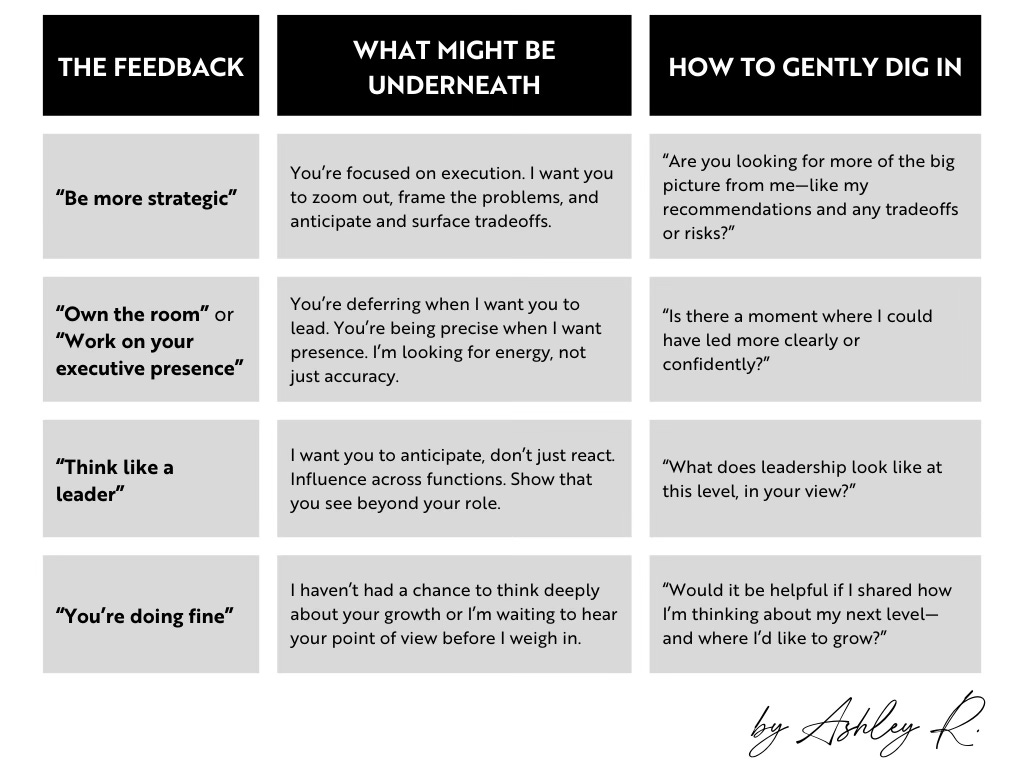The Definitive Guide to Decoding “Be More Strategic” and Other Vague Career Advice
Understanding the most common pieces of "shallow feedback" from “be more strategic” to “own the room” and responding to them without spiraling.
Welcome to this week’s newsletter! I write for high achieving professionals who rarely get the space to think through what they want next or how to lead in a way that actually works for them.
I'm Ashley Rudolph—a former tech executive turned coach for leaders and next-gen execs in the creative, tech, and lifestyle industries.
I’m feeling buzzy this week, scroll all the way to the end for a sneak preview of a surprise coming next Monday.
A couple months ago, I wrote a post called “Stop Spiraling”. It was my most-read newsletter ever.
IN CASE YOU MISSED IT →
I knew it would resonate but I didn’t realize just how deeply that it would land. There was one concept in particular that caused the most conversation. The notion that some of the most paralyzing feedback high achievers get at work is also the vaguest: shallow feedback.
DEFINITION →
Shallow feedback is vague, surface-level critique; direction that sounds important but lacks clarity or actionability.
You know the kind I mean:
“Be more strategic.”
“Think like a leader.”
“Own the room.”
“Level up.”
“Just take more ownership.”
My DMs were full after that post.
It turns out this is the moment where people feel the most stuck. When they’re succeeding enough to get feedback that sounds important, but they can’t quite unpack it.
And the response is almost universal.
You freeze. You overthink. You spiral. You go back over every meeting, every project, every sentence in your last email trying to figure out what they meant.
You get stuck in a loop of wanting to do better but at the same time not knowing what “better” means.
WHY THIS IS TIMELY →
Mid-year reviews are right around the corner for a lot of teams. And if you’re a high-performer, there’s a good chance the feedback you’ll get won’t be wrong, it may just be vague.
I wrote this for the moment when someone tells you to “be more strategic” and your stomach drops not because you aren’t willing, but because you don’t know what that actually means.
So today, we’re going to sit with that moment and walk through not just how to handle it when it happens but how to decode what the feedback means so that you can take action.
Taking action is necessary if you want to grow in your career. Sometimes it requires you taking the lead on your own development.
Feedback is one of the main ways we learn at work, but some of it won’t help you grow unless you know how to work with it. Yes, your manager should be able to get specific. But the reality is sometimes they can’t. Sometimes they won’t. And if someone hands you some sort of direction in an area where you know you want to grow (like being more strategic)… are you just going to do nothing with it?
The real question is: are you going to stay in the loop of confusion or lead your way out of it?
WHAT THIS LOOKS LIKE IN REAL LIFE
Let's be real: some feedback is like a frozen dinner.
Stick with me (lol).
It’s not that it’s totally useless but it is undercooked. And sometimes, you’re the one who has to heat it up.
That frozen dinner might look like this:
→ Your manager says, “You need to be more strategic.”
You say, “Got it!”
But inside? You’re thinking: What does that even mean? Should I speak up more? Speak less? Send a slide deck? Pull back? Push harder?
You might even go full sprint in the wrong direction, adding more context, more detail, and more urgency around everything. You might start thinking that maybe if you show just how much you know and how much work you’ve put in, it’ll land as “strategic”.
(Been there. Coached people through it. Watched it backfire.)
But here’s the thing: you don’t have to change everything you’re doing. And in most cases if you’re a high achiever, you don’t have to do more. The feedback is just a little frozen.
It needs heat. The heat is your ability to think critically, ask the right questions, and turn that vague blob into something you can work with.
CONTEXT: WHY GETTING STUCK EVALUATING SHALLOW FEEDBACK IS A CAREER BLOCKER
Let’s diagnose what’s really going on.
The biggest mistake you can make (if you want to move forward) is getting stuck in an evaluation loop, continually evaluating the quality of your manager’s feedback. That doesn’t help you improve and you can’t control it.
Managers, like all of us, have their own areas for growth and many people struggle with delivering feedback. In fact according to Gallup, only 14.5% of managers strongly agree they are good at giving feedback. That’s the reality.
So, let’s get clear on how to move forward.
Even if the feedback feels vague or underwhelming, you still have choices. You can pause, process, and ask yourself:
What part of this feels real or recurring?
What might this person be seeing or missing?
What would it look like to use this as a prompt, not a prescription?
You don’t have to wait for perfect language. You can still lead. You can still learn. You can still grow.
Because just like you wouldn’t eat a frozen meal straight from the box, you don’t have to take feedback at face value either.
You can warm it up.
You can make it useful.
And you can lead from that place of feeling curious and empowered, even when your manager isn’t giving you much to go on.
STRATEGIES & TACTICS FOR UNDERSTANDING AND RESPONDING TO SHALLOW FEEDBACK
What shallow feedback might actually mean (and how to get clarity)
I’ve been having a little too much fun with this metaphor. But it’s true. Vague feedback isn’t always wrong, it’s just undercooked.
There’s usually a signal buried in it. The trick isn’t mind-reading, it’s gaining clarity on what success probably looked like in their eyes.
What did they want more of? What didn’t land? What story are they telling themselves about what strategic, confident, or leader-like actually means?
Here are a few of the greatest hits I hear from clients and how we decode them:
DECODING SHALLOW FEEDBACK: SCREENSHOT THIS →
The “how to gently dig in” column gives you some options for understanding your manager’s feedback. They’re questions you can ask that don’t sound defensive, they sound engaged. They show you’re actively trying to close the gap.
They also signal that you’ve done some thinking and aren’t asking your manager to teach you everything you need to know. The sad truth is that leaving your manager with the impression that they have to teach you what you need to do leaves them thinking that you aren’t equipped to do the work.
Asking smart questions avoids that outcome.
And if your manager struggles to answer? That’s useful data. It’s a sign you may need to take the lead on finding clarity yourself and maybe seeking alternative forms of support, information, or development.
Alternatively, now that we know what “good” looks like, let’s also be real about what comes off as defensive, so you can be prepared for the next time it happens:
“Can you be more specific?” → This one sounds reasonable but often lands as confrontational or reactive. You respond before attempting to do any processing.
“I don’t know what that means.” → Honest, but can read as shutting down or not attempting to fully understand the issue.
“I don’t agree.” → Might be valid, but is rarely helpful in the moment as a standalone statement.
“I am being strategic, you’re just not seeing it.” → Even if it’s true, think about your end goal — this is rarely an effective way to get the outcome you desire.
These are human responses. If you’ve said them, you’re not wrong, you were just reacting. And now, it’s time to shift from reacting to responding. Responding looks like asking questions that open a conversation instead of backing someone into a corner.
That’s leadership. Even in the face of ambiguity.
And it’s exactly how we start making the shift toward thinking and communicating more strategically.
PRACTICALLY SPEAKING: A CLIENT TRANSFORMATION
What it actually looks like to become “more strategic”
Let me show you what this looks like in the wild.
One of my clients—let’s call her Maya—came to me with a clear intention:
“I want to be more strategic.”
Like a lot of high performers, she’d spent years delivering → being responsive, detail-oriented, always on top of things. But the next chapter of her career wasn’t about doing more, it was about thinking differently.
So here’s what we worked on:
She stopped framing her value around tasks and started speaking to outcomes.
She began leading meetings in partnership with executive leadership → naming risks, surfacing insights, and offering a point of view.
She delegated more of what she’d always owned solo, so she could lead across functions and not just within her lane.
She built confidence in her ability to not just execute, but influence.
Over the course of one quarter, the perception of her on the team changed.
She wasn’t just the person who could get it done, she was the person who could lead what came next.
Same brain. Same expertise.
Totally different signal.
Because being more strategic isn’t about doing extra.
It’s about getting clearer, braver, and more intentional with how you communicate the value you already bring
THE WRAP UP: CLOSING THOUGHTS
So what should you actually do next?
If you’ve gotten vague feedback and now you’re seeing yourself in this post, here’s how to move forward:
Pause and diagnose. Ask: What part of this feedback feels familiar, true, or worth exploring, even if it stung? What might this person be reacting to, even if they didn’t say it well? Is there a shift I can experiment with, even if I don’t have all the details yet?
Translate it. Use the chart above or your own judgment to figure out what the feedback might mean in your specific context.
Craft your follow-up. Come back with a few insights and a question. Think: “Here’s what I’m focusing on: XYZ. Does this direction align with what you had in mind?”
Shift your delivery. Stop overwhelming people with information. Start surfacing. Prioritize clarity over covering all your bases. Think: insights, tradeoffs, decisions, not details.
No matter what, lead. Your manager might never clarify what they meant. But you can still show up strategically.
You don’t have to wait for perfect feedback to make smart adjustments.
Want to go deeper?
If you’re the type who likes to dig in (👋🏾 hi, I see you), here are a few resources that expand on what we talked about today:
Thanks for the Feedback by Douglas Stone & Sheila Heen
One of the best breakdowns of how to receive feedback, even when it’s poorly given. Teaches you how to separate the signal from the noise.HBR: “The Feedback Fallacy”
A game-changing piece on why most feedback is ineffective and why focusing on strengths and real examples works better than generic advice.Gallup’s research on manager effectiveness
Shows how few managers are trained to coach or give quality feedback. Helps you realize it’s not personal, it’s systemic.My “Stop Spiraling” post
If you missed the one that started this conversation, catch up on it.
Good luck! See you next week.
Ashley
A SPECIAL ANNOUNCEMENT
The Operator’s Edge is evolving!
This newsletter has grown so much (thanks to y’all), and I want it to keep meeting you where you are.
Starting next week, you’ll hear from me twice a week:
Mondays → Still the same: thoughtful, introspective, and designed to help you lead with more clarity.
Thursdays → A *new* kind of note: one quick idea, links to two pieces that I can’t stop talking about in meetings, with friends, and with strangers on the internet. I’ll also include a few behind-the-scenes thoughts from my desk as a full-time coach.
And that’s not the only thing changing—I’ve also got a new name and look coming soon. You’ll see it roll over the next week.
I’m excited for what’s next. Subscribe so you don’t miss it.
SUBSCRIBE
→ Already subscribed? You’re in good company.
My readers work at places like A24, DoorDash, IDEO, Disney, and Harvard — and they’re all here for the same reason: to lead with more clarity, confidence, and intention.
If you’re not subscribed, click the subscribe button below.







Feedback as a prompt, not a prescription, is SUCH a valuable reframe for senior leaders.